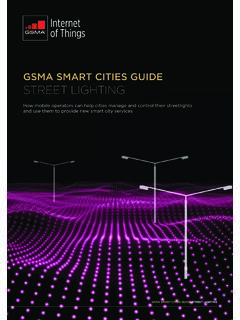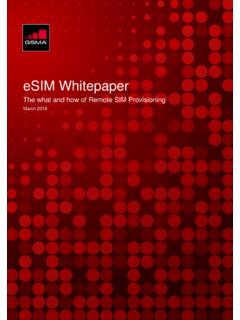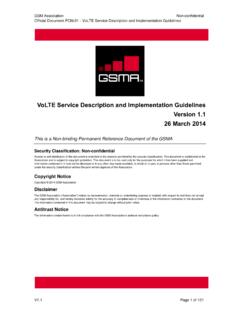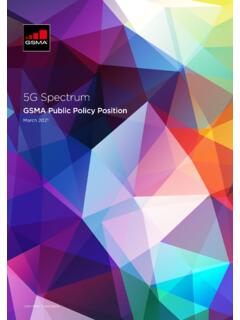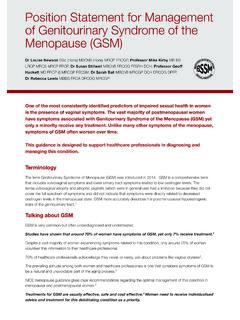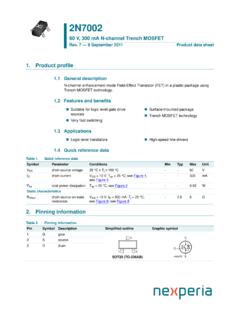Transcription of The Mobile Economy - GSMA
1 Copyright 2020 GSM AssociationMobileEconomy2020 TheGSMA Intelligence is the definitive source of global Mobile operator data, analysis and forecasts, and publisher of authoritative industry reports and research. Our data covers every operator group, network and MVNO in every country worldwide from Afghanistan to Zimbabwe. It is the most accurate and complete set of industry metrics available, comprising tens of millions of individual data points, updated daily. GSMA Intelligence is relied on by leading operators, vendors, regulators, financial institutions and third-party industry players, to support strategic decision-making and long-term investment planning. The data is used as an industry reference point and is frequently cited by the media and by the industry itself.
2 Our team of analysts and experts produce regular thought-leading research reports across a range of industry GSMA represents the interests of Mobile operators worldwide, uniting more than 750 operators with almost 400 companies in the broader Mobile ecosystem, including handset and device makers, software companies, equipment providers and internet companies, as well as organisations in adjacent industry sectors. The GSMA also produces the industry-leading MWC events held annually in Barcelona, Los Angeles and Shanghai, as well as the Mobile 360 Series of regional more information, please visit the GSMA corporate website at the GSMA on Twitter: @GSMAC ontentsExecutive summary2 The Mobile market in new decade begins as growth dominates as 5G begins to make its of the digital recover in 2019 and 2020, with modest growth out to 202516 Key trends shaping the Mobile 5G reality check: learnings one year telco of the : the battle is on to connect the home and else does the decade ahead have in store?
3 36 Mobile contributing to economic growth and addressing social challenges contribution to economic the benefits of Mobile delivering social impact45 Policies to accelerate digital development542341 Executive Summary5G learnings one year on 2019 was a pivotal year for 5G, as operators and enterprises began to stake their claim in the technology and consumers started to realise the benefits of the latest Mobile generation: Operators: Operators are increasingly seeking ways to grow revenue and cut costs in a low-growth environment, which is made more complicated by the demanding requirements of 5G services ( high speed, low latency and ultra-reliability). Operators therefore need to evolve their networks (using innovations such as virtual RAN, edge networking and network automation) to meet the demands of the 5G era.
4 They will also need to diversify their revenue streams (into areas such as pay TV, media/entertainment, advertising and IoT) to seek growth beyond core telecoms services. Enterprises: While speed gains are a well-recognised benefit of 5G, other improvements ( network slicing, edge computing and low-latency services) are not widely appreciated, with many companies believing that 4G remains good enough . Most of the key benefits for enterprises won t come until standalone 5G is deployed. The challenge, therefore, is to lay the foundations now and start the conversations about what problems 5G can solve in the future. As this is a highly competitive area given the presence of Amazon, Microsoft, Google and other cloud companies, speed to market is an important factor.
5 Consumers: Awareness and knowledge of 5G are both rising as hype makes way for reality. However, there is wide variation across the globe in terms of intentions to upgrade to 5G and the willingness to pay more for it. In general, consumers in South Korea, China and the Middle East tend to be the most willing to upgrade to 5G, while those in the US, Europe and Japan seem satisfied using 4G for the time being. 5G is still in its infancy though; as more tangible use cases are deployed, more consumers will appreciate the benefits of Mobile Economy 2020 Executive Summary2In 2019, 4G became the dominant Mobile technology across the world with over 4 billion connections, accounting for 52% of total connections (excluding licensed cellular IoT).
6 4G connections will continue to grow for the next few years, peaking at just under 60% of global connections by 2023. Meanwhile, 5G is gaining pace: it is now live in 24 markets; numerous 5G smartphones have been launched; and 5G awareness and the intention to upgrade among consumers are both on the rise. By 2025, 5G will account for 20% of global connections, with take-up particularly strong across developed Asia, North America and Europe. To support this generational shift and further drive consumer engagement, operators are expected to invest around $ trillion worldwide between 2020 and 2025 in Mobile capex, roughly 80% of which will be in 5G will be an integral part of the 5G era. Between 2019 and 2025, the number of global IoT connections will more than double to almost 25 billion, while global IoT revenue will more than triple to $ trillion.
7 The smart home is a critical battleground, with fragmentation being a major challenge to integration and adoption. There are, however, early signs that smart speakers could be at the centre of a smart home revolution in some financial headwinds, the outlook for global Mobile revenue remains stable. Following a stabilisation of pricing trends, particularly in Europe and India, and continued strong data growth in emerging markets, total Mobile revenues reached $ trillion in 2019. Revenue will rise steadily at around 1% per year out to 2025, largely because of growing revenues in enterprise IoT segments and new 5G rules, but 5G is ramping upBy the end of 2019, billion people subscribed to Mobile services, accounting for 67% of the global population.
8 Adding new subscribers is increasingly difficult as markets become saturated and the economics of reaching rural populations become more difficult to justify in a challenging financial climate for Mobile operators. Despite this, there will be around 600 million new subscribers by 2025 mostly in India, China, Pakistan and Nigeria for a total of billion subscribers to Mobile services (70% of the global population). Mobile continues to make a significant contribution to the global Economy . In 2019, Mobile technologies and services generated $ trillion of economic value added ( of GDP) globally. This figure will approach $5 trillion ( of GDP) by 2024 as countries increasingly benefit from the improvements in productivity and efficiency brought about by increased take-up of Mobile services.
9 Further ahead, 5G technologies are expected to contribute $ trillion to the global Economy between 2024 and 2034. Key sectors such as manufacturing/utilities (particularly in China) and professional/financial services (especially in MENA and North America) will benefit the most from the new is becoming harder to see, but it s still there The Mobile Economy 2020 Executive Summary3 The benefits of Mobile are reaching further than everThe connectivity gap continues to close: almost 1 billion additional people have been covered by Mobile broadband networks over the last five years. However, factors other than infrastructure are holding back the adoption of Mobile internet, namely affordability, consumer readiness, and availability of locally relevant content and services.
10 These barriers will slowly be overcome though, and by 2025 an additional billion people will start using Mobile internet for the first time, which will bring the total number of Mobile internet subscribers globally to 5 billion (over 60% of the population).With this growth in connectivity, individuals are increasingly using Mobile to access an array of life-enhancing services that contribute to and catalyse the achievement of the UN Sustainable Development Goals (SDGs). In addition, the Mobile industry is playing a key role in mitigating the catastrophic impacts of climate change, which threatens sustainable development everywhere. However, much more can be done to leverage the power of Mobile and support the delivery of the SDG 2030 targets.

